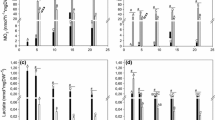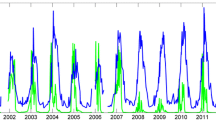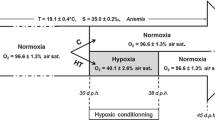Abstract
Squat lobster populations found in the Humboldt Current System over the continental shelf from ~28 to 37°S release pelagic larvae in sub-surface cold (~11 °C) hypoxic waters. Larvae subsequently spread throughout the water column encountering both normoxic and hypoxic conditions. We analyzed some short- and long-term responses of Pleuroncodes monodon larval metabolism to hypoxia at 11 °C. Routine and postprandial aerobic respiration rates were lower in hypoxia than in normoxia for all zoeal stages. Zoea V oxyconformed, while megalopae oxyregulated down to very low oxygen concentrations. Throughout zoea I development, the rate of nitrogen (protein) accumulation in zoea I was lower, and C:N ratios were higher under hypoxic conditions than in normoxia. Citrate synthase (CS) and malate dehydrogenase (MDH) apparent specific activities (as indicators of aerobic and metabolic potentials, respectively) decreased and remained at the same level, respectively, throughout zoea I reared under hypoxic conditions. Anaerobic to aerobic potential (lactate dehydrogenase (LDH)/CS) was higher in organisms reared under hypoxia, and MDH/LDH potential ratios were characteristic of organisms tolerant to hypoxia. In spite of P. monodon zoea endurance and metabolic adaptations to decreasing oxygen tensions, intense hypoxia as such of their release site would affect their overall condition especially toward the end of the molt cycle. Our results indicate the importance of considering the interaction between environmental oxygen variability and recruitment success.







Similar content being viewed by others
References
Acuña E, Alarcon R, Arancibia H, Cid L, Cortes A, Cubillos L (2010) Evaluación directa de langostino colorado y langostino amarillo entre la II y VIII Regiones, año 2009. InformeTécnico FIP. FIP/IT No 2009-15, p 366 (www.fip.cl)
Anger K (1988) Growth and elemental composition (C, H, N) in Inachus dorsettensis (Decapoda: Majidae) larvae reared in the laboratory. Mar Biol 99:255–260
Anger K (1989) Growth and exuvial loss during larval and early juvenile development of the hermit crab Pagurus bernhardus reared in the laboratory. Mar Biol 103:503–511
Anger K (1998) Patterns of growth and chemical composition in decapod crustacean larvae. Invertebr Reprod Dev 33:159–176
Anger K (2001) The biology of decapod crustacean larvae. Crustac Issues 14:1–420
Anger K, Harms J (1990) Elemental (CHN) and proximate biochemical composition of decapod crustacean larvae. Comp Biochem Physiol B 97:69–80
Aragonés J, Fraisl P, Baes M, Carmeliet P (2009) Oxygen sensors at the crossroad of metabolism. Cell Metab 9:11–22
Bahamonde N, Henríquez G, Zuleta A, Bustos H, Bahamonde R (1986) Population dynamics and fisheries of squat lobsters, family Galatheidae, in Child. In: Jamieson GS, Bourne N (eds), North Pacific workshop on stock assessment and management of invertebrates. Can Spec Publ Fish Aquat Sci 92:254–268
Bishop RE, Kakuk B, Tones JJ (2004) Life in the hypoxic and anoxic zones: metabolism and proximate composition of Caribbean troglobitic crustaceans with observations on the water chemistry of two anchialine caves. J Crustac Biol 24:379–392
Boutilier RG (2001) Mechanisms of cell survival in hypoxia and hypothermia. J Exp Biol 204:3171–3181
Brouwer M, Brown-Peterson NJ, Hoexum-Brouwer T, Manning S, Denslow N (2008) Changes in mitochondrial gene and protein expression in grass shrimp, Palaemonetes pugio, exposed to chronic hypoxia. Mar Environ Res 66:143–145
Cañete JI (1994) Dinámica larval y postlarval temprana de Pleuroncades monodon (Milne Edwards, 1837) (Crustacea: Galatheidae) en la plataforma continental de la VIII región, Chile. MSc thesis, University of Concepción, Concepción, Chile
Childress JJ (1975) The respiratory rates of midwater crustaceans as a function of depth of occurrence and relation to the oxygen minimum layer off Southern California. Comp Biochem Physiol 50A:787–799
Childress JJ, Seibel BA (1998) Life at stable low oxygen levels: adaptations of animals to oceanic oxygen minimum layers. J Exp Biol 201:1223–1232
Childress JJ, Somero GN (1990) Metabolic scaling: a new perspective based on scaling of glycolytic enzyme activities. Am Zool 30:161–173
Clarke ME, Calvi C, Domeier M, Edmonds M, Walsh PJ (1992) Effect of nutrition and temperature on metabolic enzyme activities in larval and juvenile red drum, Sciaenops ocellatus, and lane snapper, Lutjanus synagris. Mar Biol 112:31–36
Cooper RU, Clough LM, Farwell MA, West TL (2002) Hypoxia-induced metabolic and antioxidant enzymatic activities in the estuarine fish Leiostomus xanthurus. J Exp Mar Biol Ecol 279:1–20
Criales-Hernández MI, Schwamborn R, Graco M, Ayon P, Hirche J, Wolff M (2008) Zooplankton vertical distribution and migration off Central Peru in relation to the oxygen minimum layer. Helgol Mar Res 62:85–100
De Wachter B, Sartoris FJ, Pörtner HO (1997) The anaerobic endproduct lactate has a behavioural and metabolic signalling function in the shore crab Carcinus maenas. J Exp Biol 200:1015–1024
Ekau W, Auel H, Pörtner H-O, Gilbert D (2010) Impacts of hypoxia on the structure and processes in pelagic communities (zooplankton, macro-invertebrates and fish). Biogeosciences 7(1669):1699
Fagetti E, Campodonico I (1971) Larval development of the red crab Pleuroncodes monodon (Decapoda Anomura: Galatheidae) under laboratory conditions. Mar Biol 8:70–81
Flint HV, Drits AV, Pasternak AF (1991) Characteristic features of body composition and metabolism in some interzonal copepods. Mar Biol 111:199–205
Fuenzalida R, Schneider W, Garcés-Vargas J, Bravo L, Langue C (2009) Vertical and horizontal extension of the oxygen minimum zone in the eastern South Pacific Ocean. Deep Sea Res II 56:992–1003
Gallardo VA, Henríquez S, Roa R, Acuña A, Cañete I, Baltazar M (1992) Biología del langostino colorado Pleuroncodes monodon H Milne Edwards 1837 y especies afines (Crustacea, Decapoda, Anomura, Galatheidae) Sinopsis. In: Faranda F, Parra O (eds) Elementos básicos para la gestión de los recursos marinos costeros de la región del Biobio, Serie Monografía Científica 2. Centro EULA, Chile, pp 71–113
Gallardo VA, Palma M, Carrasco FD, Gutierrez D, Levin LA, Caniete JI (2004) Macrobenthic zonation caused by the oxygen minimum zone on the shelf and slope off central Chile. Deep Sea Res II 51:2475–2490
Geiger S (1999) A comparative assessment of biochemical measures of nutritional condition in pelagic organisms: Oceanic frontal systems as natural laboratories. PhD thesis. University of South Florida, Florida, USA
Gonzales RR, Quiñones RA (2000) Pyruvate oxidoreductases involved in glycolitic anaerobic metabolism of polychaetes from the continental shelf off Central-South Chile. Estuar Coast Shelf Sci 51:507–519
González RR (2002) Actividad enzimática catabólica en las comunidades plantónicas y bentónicas asociadas a la zona de mínimo oxígeno en el Sistema de la Corriente de Humbolt. PhD thesis. Universidad de Concepción. Concepción, Chile
Goolish EM (1991) Aerobic and anaerobic scaling in fish. Biol Rev 66:33–56
Grieshaber MK, Hardewing I, Kreutzer U, Pörtner HO (1994) Physiological and metabolic responses to hypoxia in invertebrates. Rev Physiol Biochem Pharmacol 125:43–147
Gutiérrez D, Enríquez E, Purca S, Quipúzcoa L, Marquina R, Flores G, Graco M (2008) Oxygenation episodes on the continental shelf of central Peru: remote forcing and benthic ecosystem response. Prog Oceanogr 79:177–189
Hagerman L, Søndergaard T, Weile K, Hosie D, Uglow RF (1990) Aspects of blood physiology and ammonia excretion in Nephrops norvegicus under hypoxia. Comp Biochem Physiol A 97:51–55
Head JM (2010) The effects of hypoxia on hemocyanin regulation in Cancer magister: possible role of hypoxia-inducible factor-1. J Exp Mar Biol Ecol 386:77–85
Hochachka PW (1997) Oxygen: a key regulatory metabolite in metabolic defense against hypoxia. Am Zool 37:595–603
Hoogewijs D, Terwilliger NB, Webster KA, Powell-Coffman JA, Tokishita S, Yamagata H, Hankeln T, Burmester KT, Rytkönen KT, Nikinmaa M, Abele D, Heise K, Lucassen M, Fandrey J, Maxwell PH, Pahlman S, Gorr TA (2007) From critters to cancers: bridging comparative and clinical research on oxygen sensing, HIF signaling, and adaptations towards hypoxia. Integr Comp Biol 47:552–577. doi:10.1093/icb/icm0722007
Ishibashi Y, Inoue K, Nakatsukasa H, Ishitani Y, Miyashita S, Murata O (2005) Ontogeny of tolerance to hypoxia and oxygen consumption of larval and juvenile red sea bream, Pagrus major. Aquaculture 244:331–340
Leferancois C, Claireaux G (2003) Influence of ambient oxygenation and temperature on metabolic scope and scope for heart rate in the common sole Solea Solea. Mar Ecol Prog Ser 259:273–284
Lehninger A (1975) Biochemistry. Worth Publishers, New York, p 1104
Lemos D, Salomon M, Gomez V, Phan VN, Buchholz F (2003) Citrate synthase and pyruvate kinase activities during early life stages of the shrimp Farfantepenaeus paulensis (Crustacea, Decapoda, Penaeidae): effects of development and temperature. Comp Biochem Physiol B 135:707–719
Levin LA (2003) Oxygen minimum zone benthos: adaptation and community response to hypoxia. Oceanogr Mar Biol Annu Rev 41:1–45
Li T, Brouwer M (2007) Hypoxia-inducible factor, gsHIF, of the grass shrimp Palaemonetes pugio: molecular characterization and response to hypoxia. Comp Biochem Physiol B 147:11–19
Madhu NV, Jyothibabu R, Ramu K, Sunil V, Gopalakrishnan TC, Nair KKC (2003) Vertical distribution of mesozooplankton biomass in relation to oxygen minimum layer in the Andaman Sea. Indian J Fish 50:533–538
Mangum CP (1997) Adaptation of the oxygen transport system to hypoxia in the blue crab, Callinectes sapidus. Am Zool 37:604–611
Marsh AG, Cohen S, Epifanio CE (2001) Larval energy metabolism and physiological variability in the Asian shore crab Hemigrapsus sanguineus. Mar Ecol Prog Ser 218:303–309
Menares B, Sepúlveda JI (2005) Grupos recurrentes de peces y crustáceos demersales en la zona centro-sur de Chile. Invest Mar 33:91–100
Mugnier C, Soyez C (2005) Response of the blue shrimp Litopenaeus stylirostris to temperature decrease and hypoxia in relation to molt stage. Aquaculture 244:315–322
Overnell J, Batty RS (2000) Scaling of enzyme activity in larval herring and plaice: effects of temperature and individual growth rate on aerobic and anaerobic capacity. J Fish Biol 56:577–589
Paschke K, Cumillaf JP, Loyola S, Gebauer P, Urbina M, Chimal ME, Pascual C, Rosas C (2010) Effect of dissolved oxygen level on respiratory metabolism, nutritional physiology, and immune condition of southern king crab Lithodes santolla (Molina, 1782) (Decapoda, Lithodidae). Mar Biol 157:7–18
Pörtner HO, Grieshaber MK (1993) Critical PO2(s) in oxyconforming and oxyregulating animals: gas exchange, metabolic rate and the mode of energy production. In: Bicudo JEPW (ed) The vertebrate gas transport cascade: adaptations to environment and mode of life. CRC Press, Boca Raton, pp 330–357
Quentin LB, Childress JJ (1976) Respiratory adaptations of Pleuroncodes planipes to its environment off Baja California. Mar Biol 38:327–334
Rosas C, Martinez E, Gaxiola G, Brito R, Diaz-Iglesia E, Soto LA (1998) Effect of dissolved oxygen on the energy balance and survival of Penaeus setiferus juveniles. Mar Ecol Prog Ser 174:67–75
Rosas C, Martinez E, Gaxiola G, Brito R, Sanchez A, Soto LA (1999) The effect of dissolved oxygen and salinity on oxygen consumption, ammonia excretion and osmotic pressure of Penaeus setiferus (Linnaeus) juveniles. J Exp Mar Biol Ecol 234:41–57
Sastry AN, Ellington WR (1978) Lactate dehydrogenase during the larval development of Cancer irroratus: effect of constant and cyclic thermal regines. Experientia 34:308–309
Schiedek D (1997) Marenzelleria viridis (Verril, 1873) (Polychaeta), a new benthic species within European costal waters. Some metabolic features. J Exp Mar Biol Ecol 211:85–101
Seibel BA (2011) Critical oxygen levels and metabolic suppression in oceanic oxygen minimum zones. J Exp Biol 214:326–336
Sellanes J, Quiroga R, Neira C, Gutiérrez D (2007) Changes of macrobenthos composition under different ENSO cycle conditions on the continental shelf off central Chile. Cont Shelf Res 27:1002–1016
Shapiro A, Bobkova A (1975) The role of malate dehydrogenase in adaptation to hypoxia in invertebrates. J Evol Biochem Physiol 11:546–547
Sokal RR, Rohlf FJ (1995) Biometry. The principles and practive of statistics in biological research. WH Freedmand and Company, New York
Somero GN, Childress JJ (1980) A violation of the metabolism-size scaling paradigm: activities of glycolytic enzymes in muscle increase in larger-size fish. Physiol Zool 53:322–337
Soñanez-Organis JG, Peregrino-Uriarte AB, Gómez-Jiménez S, López-Zavala A, Forman HJ, Yepiz-Plascencia G (2009) Molecular characterization of hypoxia inducible factor-1 (HIF-1) from the white shrimp Litopenaeus vannamei and tissue-specific expression under hypoxia. Comp Biochem Physiol C 150:395–405
Spicer JI (1995) Ontogeny of respiratory function in crustaceans exhibiting either direct or indirect development. J Exp Zool 272:413–418
Spicer JI, El-Gamal MM (1999) Hypoxia accelerates the development of respiratory regulation in brine shrimp- but at a cost. J Exp Biol 202:3637–3646
Spicer JI, Eriksonn SP (2003) Does the development of respiratory regulation always accompany the transition from pelagic larvae to benthic fossorial postlarvae in the Norway lobster Nephrops norvegicus (L.). J Exp Mar Biol Ecol 295:219–243
Spicer JI, Stroemberg JO (2003) Developmental changes in the responses of O2 uptake and ventilation to acutely declining O2 tensions in larval krill Meganyctiphanes norvegica. J Exp Mar Biol Ecol 295:207–218
Stramma L, Schmidtko S, Levin LA, Johnson GC (2010) Ocean oxygen minima expansions and their biological impacts. Deep Sea Res I 57:587–595
Sukhotin AA, Poertner HO (2001) Age-dependence of metabolism in mussels Mytilus edulis (L.) from the White Sea. J Exp Mar Biol Ecol 257:53–72
Tankersley RA, Wieber MG (2000) Physiological responses of postlarval and juvenile blue crabs Callinectes sapidus to hypoxia and anoxia. Mar Ecol Prog Ser 194:179–191
Terwillinger NB, Ryan M (2001) Ontogeny of crustacean respiratory proteins. Am Zool 41:1057–1067
Van Winkle W, Mangum C (1975) Oxyconformers and oxyregulators: a quatitative index. J Exp Mar Biol Ecol 17:103–110
Webster KA (2003) Evolution of the coordinate regulation of glycolytic enzyme genes by hypoxia. J Exp Biol 206:2911–2922
Wei LZ, Zhang XM, Li J, Huang GQ (2008) Compensatory growth of Chinese shrimp, Fenneropenaeus chinensis following hypoxic exposure. Aquacult Int 16:455–470
Wei LZ, Zhang X, Huang G, Li J (2009) Effects of limited dissolved oxygen supply on the growth and energy allocation of Juvenile Chinese Shrimp, Fenneropenaeus chinensis. J World Aquac Soc 40:483–492
Yang T-H, Lai NC, Graham JB, Somero GN (1992) Respiratory, blood, and heart enzymatic adaptations of Sebastolobus alascanus (Scorpaenidae; Teleostei) to the oxygen minimum zone: a comparative study. Biol Bull 183:490–499
Yannicelli B (2005) Distribución y transporte de larvas de crustáceos decápodos en la zona de surgencia costera de Chile Central: interacción entre comportamiento, las tolerancias fisiológicas y el período de liberación. PhD Thesis, Universidad de Concepción, Concepción, Chile
Yanicelli B, Castro LR (in press) Ecophysiological constrains on the larvae of Pleuroncodes monodon and the implications for its reproductive strategy in poorly oxygenated waters of the Peru-Chile undercurrent. J Plankton Res
Yannicelli B, Castro LR, Valle-Levinson A, Atkinson L, Figueroa D (2006) Vertical distribution and transport of decapod larvae in an equatorward facing bay of Central Chile. J Plankton Res 28:19–37
Yannicelli B, Castro L, Parada C, Schneider W, Colas F, Donoso D (2012) Distribution of Pleuroncodes monodon larvae over the continental shelf of south central Chile: field and modelling evidence for partial local retention and transport. Prog Oceanogr 92:206–227
Zeis B, Lamkemeyer T, Paul RJ, Nunes F, Schwerin S, Kock M, Schütz W, Madlung J, Fladerer C, Pirow R (2009) Acclimatory responses of the Daphnia pulex proteome to environmental changes. I. Chronic exposure to hypoxia affects the oxygen transport system and carbohydrate metabolism. BMC Physiol. doi:10.1186/1472-6793-9-7
Acknowledgments
The Chilean ‘Instituto de Fomento Pesquero’ (IFOP) kindly provided ovigerous females to conduct the experiments. We are especially thankful to Bernardo Leiva and Francisco Gallardo. Fondecyt 1010900 provided partial funding for laboratory expenses. B. Yannicelli was supported by a doctoral scholarship from the German Academic Exchange Programm (DAAD) and a Mecesup UCO 0002 scholarship. B. Yannicelli is also indebted to the staff at the Marine Biology Station in Dichato, the LOPEL working group and the LECOFIC working group for their logistic and personal support. Dr. P. Gebauer was a special support during of experiments conducted in Puerto Montt. Dr. Renato Quiñones kindly provided laboratory facilities to conduct enzymatic assays. Ricardo De Pol from the PROFC laboratory at the University of Concepción conducted the CN analysis. We also acknowledge the comments and suggestions generously provided by Dr. Luis Giménez over the course of this research and 2 anonymous reviewers.
Author information
Authors and Affiliations
Corresponding author
Additional information
Communicated by H.-O. Portner.
Rights and permissions
About this article
Cite this article
Yannicelli, B., Paschke, K., González, R.R. et al. Metabolic responses of the squat lobster (Pleuroncodes monodon) larvae to low oxygen concentration. Mar Biol 160, 961–976 (2013). https://doi.org/10.1007/s00227-012-2147-7
Received:
Accepted:
Published:
Issue Date:
DOI: https://doi.org/10.1007/s00227-012-2147-7




